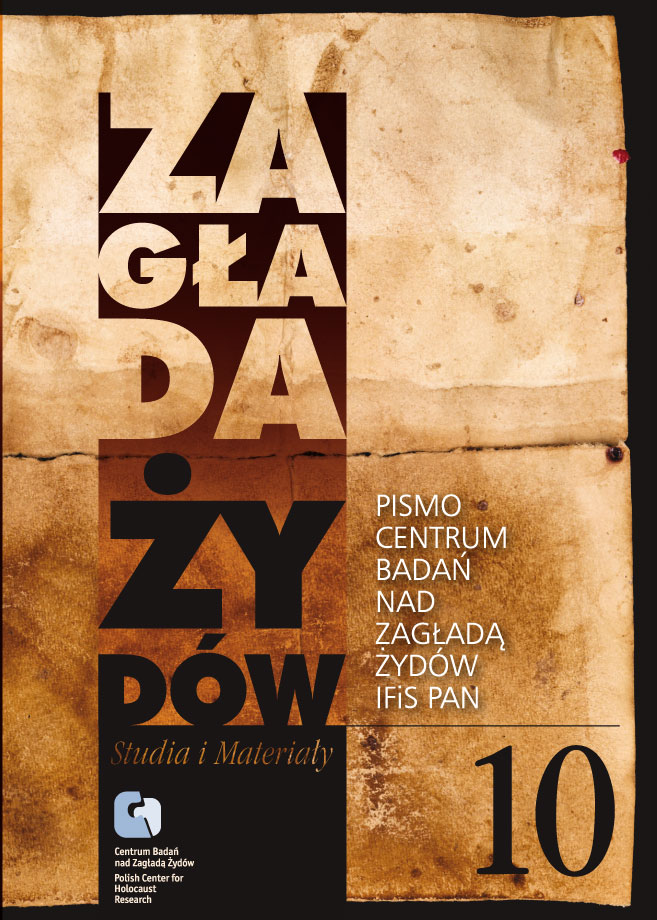Józef Kermisz (1907–2005) – twórca badań nad Szoa
Zagłada Żydów. Studia i Materiały, Nr 10 (2014), Strony: 304-316
Data zgłoszenia: 2020-10-22Data publikacji: 2014-12-01
 https://doi.org/10.32927/ZZSiM.526
https://doi.org/10.32927/ZZSiM.526
Abstrakt
Józef Kermisz (1907–2005) was a historian and an archivist who helped lay the foundations for Shoah research in Poland and Israel. In 1944 joined the Central Jewish Historical Commission where became the chief archivist. Since then his life has been devoted to retrieving wartime archival material. As archive director (in the Jewish Historical Institute in Poland and at Yad Vashem in Israel) he sought to develop an archive both for future historical research and for trials of suspected war criminal. He played a major role in discovering and preserving important documentation on the Shoah in Poland. Among his major professional achievements were preparing documentation for the prosecution in the Eichmann trial, and publishing Czerniakow’s diary and the full edition of the underground press of the Warsaw ghetto. He was one of the world’s leading experts on the Ringelblum Archive and other hidden Jewish documentation from the Holocaust. Kermisz left behind a legacy of a vast research infrastructure that he created and that will occupy scholars for generations.
Licencja
Prawa autorskie (c) 2014 Autor & "Zagłada Żydów. Studia i Materiały"

Utwór dostępny jest na licencji Creative Commons Uznanie autorstwa 4.0 Międzynarodowe.
https://creativecommons.org/licenses/by/4.0
Inne teksty tego samego autora
- Avner Shalev, Dan Michman, David Silberklang, Ścisła pamięć o Zagładzie w Muzeum Historii Holokaustu w Yad Vashem. Odpowiedź na artykuł Amosa Goldberga , Zagłada Żydów. Studia i Materiały: Nr 7 (2011)
Podobne artykuły
- Joanna Tokarska-Bakir, Logika uniku. O protokole audiencji Josepha Tenenbauma u prymasa Augusta Hlonda 3 czerwca 1946 r , Zagłada Żydów. Studia i Materiały: Nr 14 (2018)
- Luiza Nader, Pamiętanie afektywne. Moim przyjaciołom Żydom Władysława Strzemińskiego , Zagłada Żydów. Studia i Materiały: Nr 8 (2012)
- Joanna Tokarska-Bakir, Odpowiedź na recenzje Bożeny Szaynok i Marcina Zaremby , Zagłada Żydów. Studia i Materiały: Nr 14 (2018)
- Katarzyna Woniak, Ujęcie Zagłady w niemieckich podręcznikach szkolnych , Zagłada Żydów. Studia i Materiały: Nr 11 (2015)
- Maria Ferenc, Rabin Josef Lejb Gelernter ze Skępego i jego ślady w Archiwum Ringelbluma , Zagłada Żydów. Studia i Materiały: Nr 15 (2019)
- Dariusz Libionka, Alina Skibińska, “I swear to fight for a free and mighty Poland, carry out the orders of my superiors, so help me God.”Jews in the Home Army. An Episode from Ostrowiec Świętokrzyski , Zagłada Żydów. Studia i Materiały: 2008: Holocaust Studies and Materials
- Jan Grabowski, Waitman Wade Beorn, Marching into Darkness. The Wehrmacht and the Holocaust in Belarus , Zagłada Żydów. Studia i Materiały: Nr 10 (2014)
- Jan Borowicz, Bożena Keff, Strażnicy fatum , Zagłada Żydów. Studia i Materiały: Nr 16 (2020)
- Jacek Leociak, Understanding the Holocaust. A Task for Generations , Zagłada Żydów. Studia i Materiały: 2008: Holocaust Studies and Materials
- Jan Grabowski, Stefan Klemp, Freispruch für das „Mord-Bataillon”. Die NS-Ordnungspolizei und die Nachkriegsjustiz , Zagłada Żydów. Studia i Materiały: Nr 10 (2014)
<< < 1 2 3 4 5 6 7 8 9 10 11 12 13 14 15 16 17 18 19 20 21 22 23 24 25 26 27 28 29 30 31 32 33 34 35 36 37 38 39 40 41 42 43 44 45 46 47 48 49 50 > >>
Możesz również Rozpocznij zaawansowane wyszukiwanie podobieństw dla tego artykułu.
 English
English
 Język Polski
Język Polski








